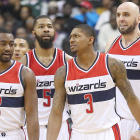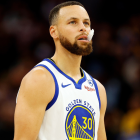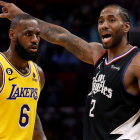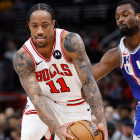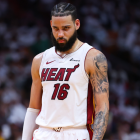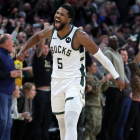The last time the Washington NBA basketball team won a division title, it didn’t rate as much of a story.
The Bullets beat the Detroit Pistons on March 25, 1979, 116-107. The defending NBA champions, recently converted to the Atlantic Division from the Central the year before, easily beat the Julius Erving/Bobby Jones/Daryl Dawkins Sixers for the crown, winning the Atlantic by seven games.
They even clinched that day without Mitch Kupchak, out with a sore back. (To be fair, Detroit was without Hal Lanier.)
And yet, prior to the 2016-17 season, it would be the last title the Wizards would ever win.
Some of that makes sense when looking at the cold reality of the aging process. The team’s leading scorer, Elvin Hayes, was 33 in 1978-79. Their second-leading scorer, Bob Dandridge, was 31. The center, Wes Unseld, was 32. So expecting some decline from this vital trio had to be expected. But only Dandridge fell off a cliff in production right after, 1978-79 his final All-Star season.
But the younger Bullets failed to develop for a variety of reasons, and we all know what happened next: nearly four decades of darkness.
So how does the future of these Wizards look in comparison to the Washington team that charged full speed into the 1980s, only to falter? Let’s compare by position.
CENTER
Those Bullets had Unseld, a Hall of Famer still near the top of his game. He averaged a double-double for the sixth and final time in his career, falling short of the accomplishment in six other seasons not for lack of rebounds, but rather points. The Unseld fallback plan was Dave Corzine, a rookie out of Purdue who went on to a productive career -- just not with Washington, which traded him in 1980 for a pair of second-round picks.
By comparison, Marcin Gortat would appear to fall well short of Unseld. But not only is his 2016-17 all-but-ripped out of the Unseld career line (10.7 points, 10.4 rebounds), Gortat also shows no signs of slowing down, but he’s 33, so that better hold true over the two seasons he has remaining on his contract. And he’s backed up by defensive stalwart Ian Mahinmi and the versatile offensive repertoire of Jason Smith, with both signed beyond this season.
ADVANTAGE: 2016-17 Wizards
POWER FORWARD
Those Bullets were defined in many ways by Elvin Hayes, whose combination of ferocious rebounding and unstoppable scoring created a mismatch for any team already dealing with Unseld’s unselfish passing out of the post. But as mentioned above, the future after Hayes needed to be accounted for, and the Bullets looked like they’d done so, selecting Mitch Kupchak with the 13th pick in the 1976 draft. In his first three seasons, Kupchak managed to score 13.7 points per game despite averaging fewer than 23 minutes per contest. (That injuries ultimately curtailed both his ability to stay on the floor and produce while there was not yet in evidence.)
These Wizards, meanwhile, employ Markieff Morris, a capable stretch four in the middle of his successful career out of Kansas, and still just 27. Still, no disrespect to Morris, but there’s no comparison between his peak and even the decline phase of the Big E, let alone Kupchak’s upside at that time. Even adding in the potential of Chris McCullough, it’s not close.
ADVANTAGE: 1978-79 Bullets
SMALL FORWARD
Bob Dandridge is a player not often discussed, considering the elite career he had. Adding Dandridge as a free agent prior to 1977-78 is arguably the move that propelled the Bullets to their NBA title in 1978, with Dandridge average 21.2 points per game during that successful playoff campaign. He made four All-Star teams -- the last coming in 1978-79 -- before scoring at a 23.1 points per game clip in the 78-79 playoffs. At 31, there was little reason to think he’d decline so fast. And in Kevin Grevey and Greg Ballard, the Bullets also had a pair of mid-20s small forwards ready to step in. The three stood out as the deepest place on the roster.
Compared to that trio, it is hard for Otto Porter and Kelly Oubre to measure up. Porter, though, may be able to do it. Let’s not forget that Porter is a high lottery pick, making his emergence this season less of a surprise than it’s been portrayed in many places. He’s hyper-efficient, shooting better than 43 percent from three, and he rebounds and defends well at the position. Best of all, he doesn’t turn 24 until June. Oubre is even younger, just 21. Assuming the Wizards give Porter the max deal he has coming to him, their future is bright at the small forward spot.
ADVANTAGE: Push
SHOOTING GUARD
A brief elegy to Charles Johnson, starting shooting guard for the Bullets: he played all 82 games in 1978-79, his final season. The year before, he scored 80 points over the final four games of the NBA Finals against Seattle. Elvin Hayes called him the reason the Bullets won it all. And he was backed up by three-time All Star Phil Chenier, though past his best seasons, and young scorer Roger Phegley.
But, you know, there’s no real debate here. Bradley Beal won’t even be 24 until June. He’s signed through 2020-21. He’s shooting better than 40 percent from three, and sits just behind John Wall for the team lead in scoring per game. He’s got Bojan Bogdanovic behind him (a restricted free agent who it wouldn’t be surprising to see return to Washington) and Tomas Satoransky, signed through next season, around as well. But the future looks far bleaker if either of them needs to start regularly instead of Beal.
ADVANTAGE: 2016-17 Wizards
POINT GUARD
Let’s start here: Tom Henderson could play. The Bronx native received All-American honors playing for the Hawaii Rainbows, got picked seventh overall by the Hawks, and came to the Bullets in a deal that also contained a Truck [Robinson] and a Tree [Rollins]. His capable backup, Larry Wright, was a Bullets’ selection one pick after Kupchak in the 1976 draft. It was a capable duo, both in their mid-20s.
But, well, John Wall is an easy Hall of Famer merely by continuing at his current level for another five seasons. He’s somehow managed to get better this season, posting both his most efficient shooting and highest assist percentage of his career. No longer does anyone question whether he can be the best player on a championship team. And he’s still just 26.
ADVANTAGE: 2016-17 Wizards
FINAL ANALYSIS
The 2016-17 Wizards look like the better-positioned team for the future. Much of that comes down to age: While the three best Bullets were all 31 or older, Beal, Wall and Porter haven’t celebrated a 27th birthday between them yet. Now, a warning: Merely being better than the 1979-80 and beyond Bullets doesn’t guarantee much. That year, Washington finished 39-43, losing in the first round of the playoffs, then finished 39-43 in 1980-81 and missing the postseason altogether.
By the time they returned to the playoffs in 1981-82, it was due to guys like Ballard and Grevey, yes, but also newcomers Jeff Ruland and Rick Mahorn. It’s difficult to see into the future, even in hindsight. And anyone you’d told back in 1979 about the blackness that overcame the Washington basketball team for decades would have been the first to doubt you.









